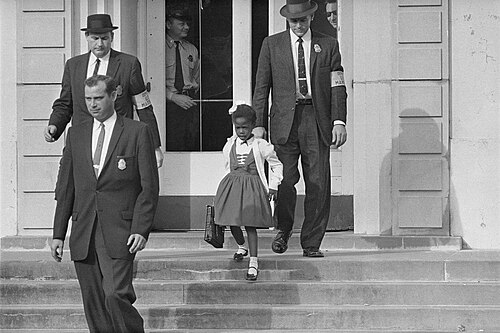Talk:Ruby Bridges
| This is the talk page for discussing improvements to the Ruby Bridges article. This is not a forum for general discussion of the article's subject. |
Article policies
|
| Find sources: Google (books · news · scholar · free images · WP refs) · FENS · JSTOR · TWL |
| Archives: 1Auto-archiving period: 30 days |
| This article must adhere to the biographies of living persons (BLP) policy, even if it is not a biography, because it contains material about living persons. Contentious material about living persons that is unsourced or poorly sourced must be removed immediately from the article and its talk page, especially if potentially libellous. If such material is repeatedly inserted, or if you have other concerns, please report the issue to this noticeboard.If you are a subject of this article, or acting on behalf of one, and you need help, please see this help page. |
| This It is of interest to the following WikiProjects: |
||||||||||||||||||||||||||||||||||||||||||||||||||||||||||||||||
| ||||||||||||||||||||||||||||||||||||||||||||||||||||||||||||||||
| A fact from this article was featured on Wikipedia's Main Page in the On this day section on November 14, 2016, November 14, 2018, and November 14, 2023. |
Updates requested[edit]
Hello, Can the page please be updated? Here is one link (of many reporting right now):
- https://www.tampabay.com/news/education/2023/03/27/removal-ruby-bridges-film-pinellas-school-sparks-outrage/ Lazurshetrodyne (talk) 16:43, 27 March 2023 (UTC)
Featured picture scheduled for POTD[edit]
Hello! This is to let editors know that File:US Marshals with Young Ruby Bridges on School Steps.jpg, a featured picture used in this article, has been selected as the English Wikipedia's picture of the day (POTD) for September 8, 2024. A preview of the POTD is displayed below and can be edited at Template:POTD/2024-09-08. For the greater benefit of readers, any potential improvements or maintenance that could benefit the quality of this article should be done before its scheduled appearance on the Main Page. This is for her 70th birthday. If you have any concerns, please place a message at Wikipedia talk:Picture of the day. Thank you! Adam Cuerden (talk)Has about 8.7% of all FPs. 07:38, 16 January 2024 (UTC)

|
|
Ruby Nell Bridges Hall (born September 8, 1954) is an American civil rights activist. She was the first African American child to attend formerly whites-only William Frantz Elementary School in Louisiana during the New Orleans school desegregation crisis on November 14, 1960. Bridges attended a segregated kindergarten in 1959. In early 1960, Bridges was one of six black children in New Orleans to pass the test that determined whether they could go to the all-white William Frantz Elementary School. Two of the six decided to stay at their old school, Bridges went to Frantz by herself, and three children (Gail Etienne, Leona Tate and Tessie Prevost) were transferred to the all-white McDonogh No. 19 Elementary School. All four 6-year-old girls were escorted to school by federal marshals during the first day they attended the two schools. In the following days of that year, federal marshals continued to escort them. That first day, Bridges and her mother spent the entire day in the principal's office; the chaos of the school prevented their moving to the classroom until the second day. On the second day, however, a white student broke the boycott and entered the school when a 34-year-old Methodist minister, Lloyd Anderson Foreman, walked his five-year-old daughter Pam through the angry mob, saying, "I simply want the privilege of taking my child to school…" A few days later, other white parents began bringing their children, and the protests began to subside. Yet Bridges remained the only child in her class, as she would until the following year. Every morning, as Bridges walked to school, one woman would threaten to poison her, while another held up a black baby doll in a coffin. This led the U.S. Marshals dispatched to oversee her safety to only allow Bridges to eat the food that she brought from home, and she was not allowed to participate in recess. As of 2004, Bridges, now Ruby Bridges Hall, still lived in New Orleans with her husband, Malcolm Hall, and their four sons. After graduating from a desegregated high school, she worked as a travel agent for 15 years and later became a full-time parent. She is now chair of the Ruby Bridges Foundation, which she formed in 1999 to promote "the values of tolerance, respect, and appreciation of all differences". Describing the mission of the group, she says, "racism is a grown-up disease and we must stop using our children to spread it." Photograph credit: Department of Justice; restored by Adam Cuerden
Recently featured:
|
- Biography articles of living people
- C-Class vital articles
- Wikipedia level-5 vital articles
- Wikipedia vital articles in People
- C-Class level-5 vital articles
- Wikipedia level-5 vital articles in People
- C-Class vital articles in People
- C-Class biography articles
- WikiProject Biography articles
- C-Class WikiProject Women articles
- All WikiProject Women-related pages
- WikiProject Women articles
- C-Class Civil Rights Movement articles
- High-importance Civil Rights Movement articles
- WikiProject Civil Rights Movement articles
- C-Class United States articles
- High-importance United States articles
- C-Class United States articles of High-importance
- C-Class Louisiana articles
- High-importance Louisiana articles
- WikiProject Louisiana articles
- C-Class Mississippi articles
- Unknown-importance Mississippi articles
- WikiProject Mississippi articles
- C-Class United States History articles
- High-importance United States History articles
- WikiProject United States History articles
- WikiProject United States articles
- C-Class Discrimination articles
- High-importance Discrimination articles
- WikiProject Discrimination articles
- C-Class African diaspora articles
- High-importance African diaspora articles
- WikiProject African diaspora articles
- C-Class Black Lives Matter articles
- High-importance Black Lives Matter articles
- Selected anniversaries (November 2016)
- Selected anniversaries (November 2018)
- Selected anniversaries (November 2023)











